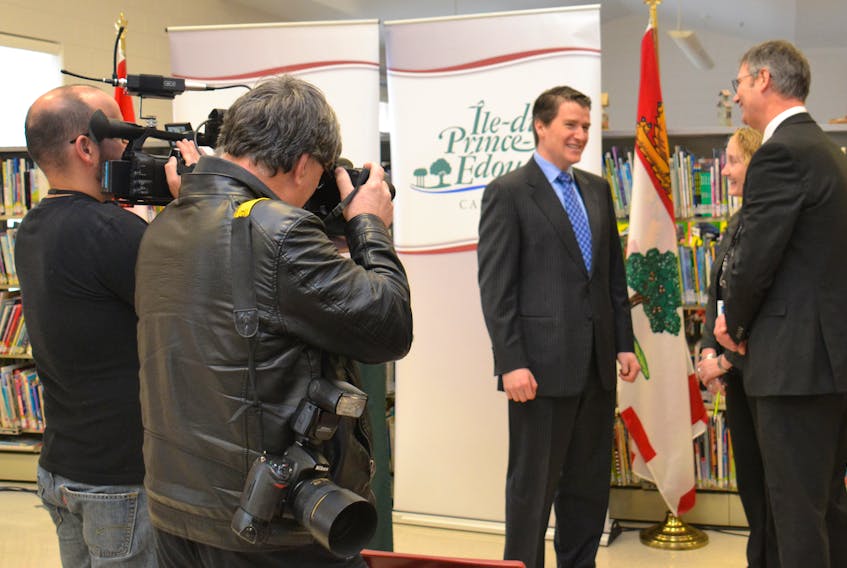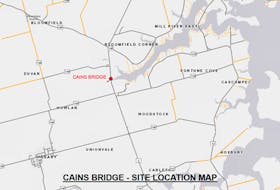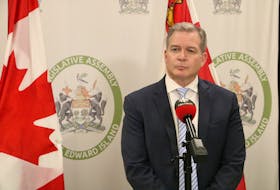Government calls it communications. Others call it spin.
Whatever name you’d like to use, the P.E.I. government spends millions each year from the public purse to sell itself and its messaging to Islanders.
According to documents released to The Guardian through freedom of information, the province’s communications branch spent close to $1 million on advertising, professional services and equipment since Premier Wade MacLauchlan began his tenure in office in January 2015.
Another $2.2 million is spent every year in salaries for the team of 31 staffers who work for Communications P.E.I.
This provincial communications team works diligently to document and plan ways to package and promote government messaging.
It’s a practice that governments everywhere have increasingly been honing.
Marc Dagenais, manager of strategic communications for the province, says the messaging they create is mainly aimed at promoting services and initiatives important for public safety and well being – campaigns like one encouraging Islanders to be screened for colorectal cancer or another highlighting the low-risk drinking guidelines.
“These are important things to get out and get those messages to the public,” Dagenais said.
He also pointed to ad campaigns the province has created that promote government programs that help Islanders retrofit their homes to be more energy efficient and others that raised awareness about job fairs for Islanders looking for work.
“If we’re going to have these programs it’s important that people are aware of them and they can take advantage of them.”
By the numbers
Top P.E.I. government advertising expenses by merchant January 2015 to May 2017
- Newcap radio - $295,773
- Transcontinenal Media - $290,669
- Maritime Broadcasting System (MBS) Ltd. - $104,876
- Island Press Ltd. - $57,251
- Results Marketing & Advertising - $46,552
- Imageworks (PEI) Inc. - $33,780
- La Voix Acadienne - $29,960
- Canadian Cancer Society - $25,000
- Canadian Broadcasing Corp (CBC) - $23,437
- Facebook - $22,407
But journalism instructor Rick MacLean calls this practice a form of government “spin” that can’t help but be aimed at garnering public support.
“Government and the spin industry are far better prepared, far better funded and, in some cases, unfortunately, far more sophisticated than the people who are receiving these messages and interpreting them,” MacLean says.
“The irony is, what they’re doing is they’re buying your support with your money.”
MacLean teaches journalism at Holland College and UPEI, and one of the courses he has developed is called “manipulation and the media.”
In it, he showcases real-life examples of how governments past and present use focused and targeted tactics to sell ideas and messages, often under the guise of public service or safety, but with the ultimate goal of selling political ideas to the public.
“I guarantee you every time a message arrives, there’s an agenda behind it,” MacLean said.
“Of course government should be telling us about what the services are, but inevitably you have this temptation, when you’ve got all this money and all this expertise and all this time and when you’ve got so much at stake – because it’s win or lose in politics – that as a result there’s this enormous temptation to sneak in that little bit of extra on the side that says, ‘Meanwhile, we’re the only ones who can do this for you and you should vote for us next time.’”

The lion’s share of money spent on communications in P.E.I. goes to salaries.
Most of the province’s communications officers make between $59,000 and $83,000 a year. There are also a number of graphic designers, content creators and technical staff who help create and distribute government messaging.
Increasingly, these staffers have been creating content that is packaged to look and feel like news stories created by journalists. They include feature-style photos, many of which showcase government ministers and MLAs.
Government communications employees “covering” news events often outnumber the journalists who are present. A provincial photographer is always on hand for news conferences and, increasingly, so is a provincial videographer.
"... When the game is stacked, when you’ve got a public that is increasingly in the modern media world, struggling to understand the difference between news and this thing that looks just like news, and you’ve got media that are struggling with fewer people and increased demands… you have a very muddy place where it’s not clear who you’re supposed to trust and what is real news and what is just a well-disguised sales pitch.”
-Journalism instructor Rick MacLean
Last month, Education Minister Jordan Brown called a news conference to announce the province would be spending $2 million to clear a backlog of children in the school system waiting for psychological assessments.
After finishing a scrum with a handful of journalists, Brown was taken aside by a government communications staffer who conducted a TV-style interview with Brown and the provincial videographer for the province’s “coverage” of the event.
The communications branch of the P.E.I. government has been growing its video output, with a number of high-quality videos promoting provincial initiatives, often featuring politicians, appearing on the province’s official Youtube channel.
Communications staffers have also started regularly live-streaming news conferences and events, such as cabinet shuffles and speeches delivered by the premier.
For these initiatives they have purchased equipment, including $86,000 for video cameras and supporting equipment and thousands more on other image, audio and software purchases.
Despite having a team of dedicated communications staffers, the province also hires outside help for some of its media campaigns. A total of $128,000 was paid to photographers, musicians and creative services companies for ads like “Choose P.E.I.” and a radio ad recorded by the premier. Another $46,000 was paid to local advertising firm Results Marketing to create brochures and ads promoting government spending initiatives and programs.
After salaries, the most money goes to advertising.
Between Jan. 15, 2015 and May of 2017, the province spent more than $820,000 on ads and advertising initiatives.
The largest sums went to Newcap Radio, which owns the Ocean 100.3 and Hot 105.5 FM stations, and to Transcontinental Media, the former owner of The Guardian and the Journal-Pioneer. They were paid $295,773 and $290,669 for provincial advertisements, respectively.
Maritime Broadcasting Systems Ltd. (MBS) radio, which owns the Q93, CFCY and SPUD FM stations, was also a beneficiary of generous government advertising expenses at $104,876.

But while larger sums are earmarked for local media organizations, a growing number has been spent on overseas companies for sponsored content. Government spent more than $22,000 to promote government programs and campaigns on Facebook. A further $11,200 was spent on Linkedin, $5,600 for Google advertising and more than $2,800 on Twitter ads.
The strategic plans for each of the province’s advertising campaigns include a detailed execution strategy, complete with targeted audiences, a “path to engagement” and a multi-pronged approach to publicity. This includes paid social media posts, which are feature stories written by government staff. Government sometimes pays to boost the visibility of these posts on social media platforms.
The province also purchases Google ads and the 30-second ad space at the beginning of YouTube videos.
Print and broadcast advertising in traditional media outlets is often used as well, which are the most expensive ad purchases.
Dagenais says the advertising budget within Communications P.E.I. has been steadily declining in recent years, which is why his team has been making greater use of lower-cost options like social media.
But using different platforms requires more creativity, he said.
“We’ve been asked by citizens to try make these messages as effective as we can. If you’re going to post things to social media, they have to be different than a press release,” Dagenais explained.
“That’s why we would create the content somewhat differently if it’s primarily targeted to go out in a social media environment than it would be if it’s in a formal press release.”
The province has recently created new “channels” on Facebook to try to attract larger, more targeted audiences.
Dagenais says this is more effective than creating a Facebook page called “the Department of Family and Human Services” to get people to see and engage with their content.
“Rather than putting up different channels for different departments, we wanted to create different channels for different audiences. So hopefully seniors who are using Facebook – and we know that is our fastest-growing audience – they could like that page and we could put things there that would be more specific to them.”
MacLean says this kind of packaging is slipping dangerously close to “propaganda,” which can confuse the public and work to government’s advantage.
“The government is trying to win the game one inch at a time,” he said.
“And when the game is stacked, when you’ve got a public that is increasingly in the modern media world, struggling to understand the difference between news and this thing that looks just like news, and you’ve got media that are struggling with fewer people and increased demands… you have a very muddy place where it’s not clear who you’re supposed to trust and what is real news and what is just a well-disguised sales pitch.”









